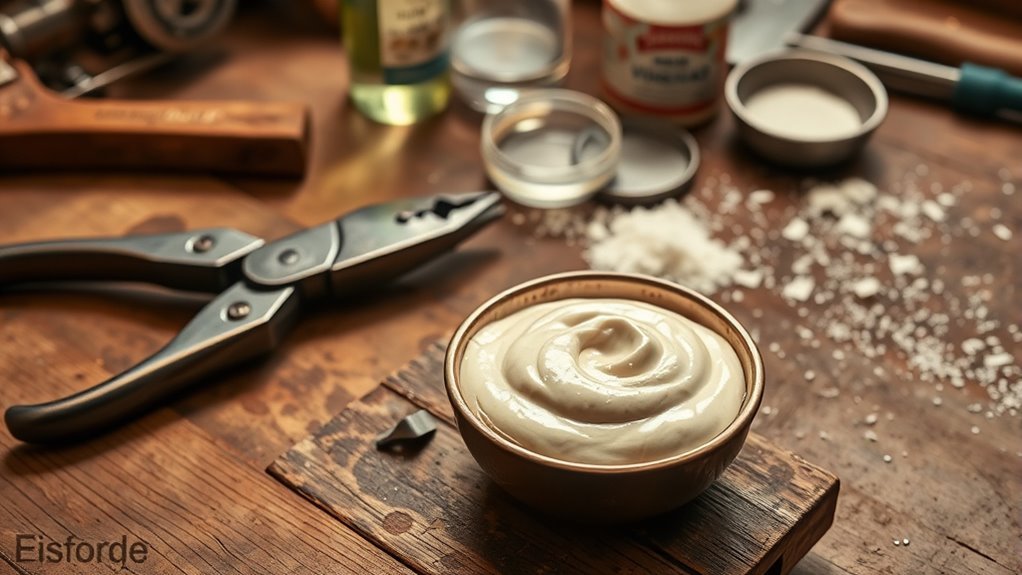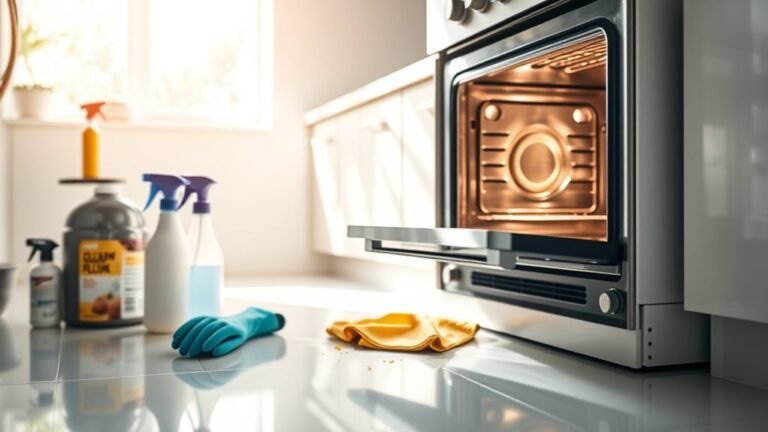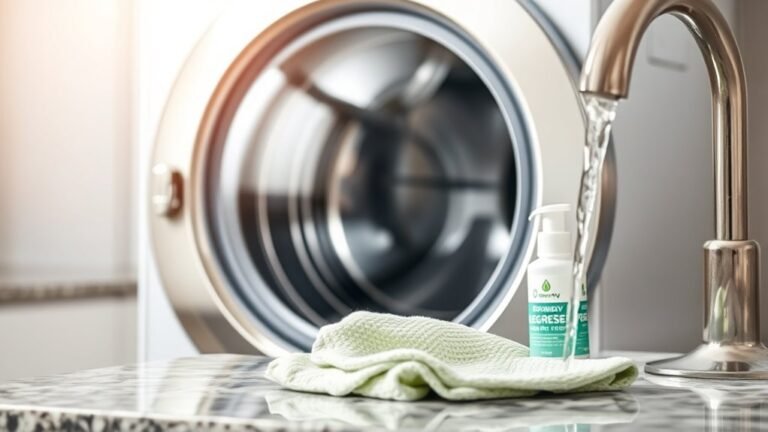How to Remove Rust From Household Tools and Surfaces
You can remove rust from your household tools by soaking them in white vinegar for several hours or applying a baking soda paste for mild stains. Scrubbing with a brush or sanding also works well for tougher spots. Always wear gloves and work in a ventilated area for safety. After cleaning, dry tools thoroughly and consider applying a protective coating to prevent future rust. Keep going to find out more effective rust removal and prevention tips.
Identifying Rust on Different Household Items

Before you can effectively remove rust, you need to recognize it on your household tools. Rust appearance indicators often include rough, flaky patches that disrupt the smooth surface of metal items. You might notice rust color variations ranging from bright orange to deep reddish-brown, signaling different stages of oxidation. Sometimes, rust forms as small spots, while other times it spreads into larger, more stubborn areas. Paying attention to these signs will help you pinpoint which tools need attention before rust worsens. Being able to identify rust quickly frees you from the frustration of damaged items and keeps your tools ready for action. Recognizing rust early lets you take control and maintain your gear without letting corrosion limit your freedom to work or create.
Safety Precautions Before Starting Rust Removal
Although rust removal can seem straightforward, taking proper safety precautions is essential to protect yourself from potential hazards. Before you start, make sure you wear gloves for protection—the chemicals and scrubbing can irritate or damage your skin. Don’t skip eye protection either; rust particles and cleaning agents can easily get into your eyes, causing discomfort or injury. Work in a well-ventilated area to avoid inhaling fumes from any rust removers you use. Keep your workspace clear and organized to prevent accidents, and always read labels on any products to understand their risks. By prioritizing these safety steps, you’ll enjoy the freedom to restore your tools without compromising your well-being. Safety isn’t restrictive—it’s empowering.
Using White Vinegar to Dissolve Rust

You’ll want to soak your rusty tools in white vinegar for several hours to let the acid break down the rust effectively. Make sure the tools are fully submerged, and check them periodically to avoid over-soaking. After soaking, scrub the rust away with a brush for best results.
Soaking Time Guidelines
Since white vinegar works by breaking down rust, soaking time is key to getting the best results. You’ll want to soak your tools long enough to let the acid dissolve the rust but not so long that the metal weakens. A soaking duration of 3 to 12 hours usually hits the sweet spot. For heavier rust, you can push toward the longer end, but check regularly. Ideal temperatures for soaking fall between 70°F and 90°F (21°C to 32°C). Warmer conditions speed up the process, so try to keep your soaking container in a warm, dry spot. Avoid freezing or very cold environments, as they slow the vinegar’s effectiveness. By controlling soaking duration and temperature, you free yourself from stubborn rust without damaging your tools.
Vinegar Application Tips
When applying white vinegar to rusted tools, it’s important to guarantee full coverage for the acid to work effectively. You can either soak smaller items directly in vinegar or use a cloth soaked in vinegar to cover larger surfaces. Keep in mind, the vinegar benefits include its natural acidity, which breaks down rust without harsh chemicals. For stubborn rust, multiple applications might be necessary, so don’t hesitate to reapply. If you’re seeking vinegar alternatives, lemon juice or citric acid can also do the trick, offering similar rust-dissolving power with a fresh scent. Whichever method you choose, make sure to rinse and dry your tools thoroughly afterward to prevent new rust from forming. This approach keeps you in control, preserving your tools and your freedom from costly replacements.
Baking Soda Paste for Mild Rust Stains
Although baking soda might seem like a simple kitchen staple, it’s surprisingly effective at tackling mild rust stains on your tools. This easy rust removal method lets you regain control over your gear without harsh chemicals. Here’s how you can use baking soda paste:
- Mix baking soda with water to form a thick paste.
- Apply the paste generously over the rusted spots.
- Let it sit for about an hour, then scrub gently with a brush or cloth.
Rinse the tool with water and dry it thoroughly to prevent more rust. This method is perfect when you want a quick, eco-friendly solution that keeps your tools rust-free and ready for action. Give it a try—you’ll love the freedom of restoring your tools yourself!
Lemon Juice and Salt Combination Method

Two simple ingredients—lemon juice and salt—can work wonders on stubborn rust spots. The lemon juice benefits you by naturally breaking down rust thanks to its acidity, while salt properties act as a gentle abrasive to scrub away corrosion without damaging your tools. To use this method, sprinkle salt over the rusted area, then squeeze fresh lemon juice on top until it’s soaked. Let it sit for a couple of hours, allowing the mixture to loosen the rust. Afterward, scrub the spot with a cloth or brush, and rinse thoroughly with water. This combination frees your tools from rust without harsh chemicals, giving you control over the process while preserving their integrity. It’s a simple, effective way to reclaim your gear and maintain your independence.
Applying Commercial Rust Removers Safely
When picking a commercial rust remover, make sure it’s suitable for the type of tool you have. You’ll want to follow all safety instructions carefully, including wearing gloves and working in a well-ventilated area. Taking these precautions helps you get the best results without risking harm.
Choosing the Right Product
How do you pick the best rust remover without risking damage to your tools or your health? Choosing the right product means balancing product effectiveness with safety and compatibility. Here’s how you can make a smart choice:
- Know the product types: There are gels, sprays, and liquids. Gels cling to vertical surfaces, sprays cover large areas quickly, and liquids soak rust away—pick what fits your project.
- Check product effectiveness: Look for reviews or labels indicating how well it handles rust severity and metal types. Some products work better on light rust, others on heavy corrosion.
- Consider material compatibility: Make sure the remover won’t harm your tool’s metal or finishes. You want freedom to restore without causing new damage.
Choosing wisely lets you reclaim your tools safely and effectively.
Safety Precautions and Tips
Once you’ve picked the right rust remover for your tools, it’s important to handle it carefully to avoid accidents or damage. Start by gearing up with proper protective gear—gloves, goggles, and a mask—to shield your skin, eyes, and lungs from harsh chemicals. Next, focus on workspace preparation: choose a well-ventilated area to keep fumes at bay and lay down newspapers or plastic sheets to protect surfaces. Follow the product instructions exactly—don’t mix chemicals or use more than recommended. Keep kids and pets away while you work to maintain a safe environment. After applying the remover, rinse and dry your tools thoroughly to prevent new rust from forming. By respecting these precautions, you’ll enjoy rust-free tools without compromising your freedom or safety.
Mechanical Methods: Scrubbing and Sanding Rust Away
Although chemical treatments can be effective, you might find that mechanical methods like scrubbing and sanding give you quicker, more immediate results for removing rust from your tools. Using the right scrubbing techniques and sanding tools, you can reclaim your gear without waiting.
Mechanical scrubbing and sanding often deliver faster, more immediate rust removal results than chemical treatments.
Here’s a simple approach:
- Start with a wire brush or steel wool for heavy rust—scrub firmly but carefully.
- Use sanding tools like sandpaper or a sanding block to smooth out stubborn rust spots, starting with coarse grit and moving finer.
- Rinse and dry your tool thoroughly after scrubbing and sanding to remove debris.
These mechanical methods put you in control, letting you tackle rust head-on and restore your tools to freedom-ready condition, no chemicals necessary.
Preventing Future Rust Formation on Tools and Surfaces
To keep your tools rust-free, you’ll want to adopt a few simple habits that prevent moisture and oxidation from taking hold. First, applying rust resistant coatings is a powerful way to shield metal surfaces. These coatings act as barriers, stopping water and air from triggering corrosion. Next, focus on proper storage—keep your tools in dry, well-ventilated areas. Avoid leaving them exposed to humidity or outdoor elements, which accelerate rust formation. Consider using airtight containers or toolboxes with desiccants to absorb moisture. Regularly checking and cleaning your tools before storage also helps. By combining rust resistant coatings with proper storage practices, you’ll protect your tools effectively, ensuring they stay in great shape and ready for use whenever you need them.
Tips for Maintaining Rust-Free Household Items
When you want to keep your household items rust-free, regular care and attention make all the difference. Staying proactive helps you avoid the hassle of rust removal and keeps your tools ready for action. Here are three practical tips:
Regular care and proactive attention keep your household items rust-free and ready for action.
- Optimize Tool Storage: Store your tools in a dry, well-ventilated place. Use airtight containers or toolboxes with moisture absorbers to prevent humidity from causing rust.
- Conduct Regular Inspections: Check your tools frequently for early signs of rust or moisture. Catching problems early means you can clean and dry them before rust sets in.
- Apply Protective Coatings: Use oils or rust inhibitors on metal surfaces after cleaning. This creates a barrier against moisture and keeps your items in top shape.
Following these simple steps gives you the freedom to use your tools without worrying about rust damage.
Frequently Asked Questions
Can Rust Removal Damage the Metal’s Structural Integrity?
You might worry that rust removal could cause metal fatigue or weaken your tools, but if you choose the right treatment methods, it shouldn’t harm the metal’s structural integrity. Harsh chemicals or aggressive sanding can damage the surface, so it’s key to use gentle, appropriate techniques. By doing this, you maintain freedom to use your tools confidently, keeping them strong and reliable without risking unnecessary wear or fatigue.
How Long Does Rust Take to Form on Untreated Tools?
Rust formation timeline varies, but you could see rust starting on untreated tools within a few days to weeks. It really depends on environmental factors like humidity, moisture, and exposure to salt or chemicals. If your tools are left in damp or salty conditions, rust can develop faster, limiting your freedom to use them when you want. Protecting your tools helps you avoid that frustration and keeps them ready whenever you need.
Are There Eco-Friendly Alternatives to Commercial Rust Removers?
Absolutely, you can ditch harsh chemicals and try eco-friendly alternatives like a vinegar solution or baking soda paste. Soak your rusty items in vinegar for a few hours or scrub them with baking soda mixed with water. These natural options work great without harming the environment, giving you the freedom to clean effectively while staying green. Plus, they’re easy to find and super budget-friendly!
Does Rust Removal Affect Painted or Coated Surfaces?
Rust removal can be a double-edged sword—you want to save your tools, not strip them bare. When you tackle rust, you might unintentionally cause paint damage or harm the protective coating that keeps surfaces safe. Harsh chemicals or abrasive methods can eat away at these layers, leaving your items vulnerable. To keep your freedom intact, choose gentle techniques that respect the original finish, preserving both function and flair.
Can Rust Cause Health Issues if Left Untreated?
If you ignore rust, you might face some rust health risks. While rust itself isn’t highly toxic, prolonged rust exposure can lead to symptoms like skin irritation, infections, or even tetanus if you get cut by rusty metal. It’s smart to handle rusty items with care and keep wounds clean. Taking control means protecting your freedom to enjoy life without unnecessary health worries linked to rust.






